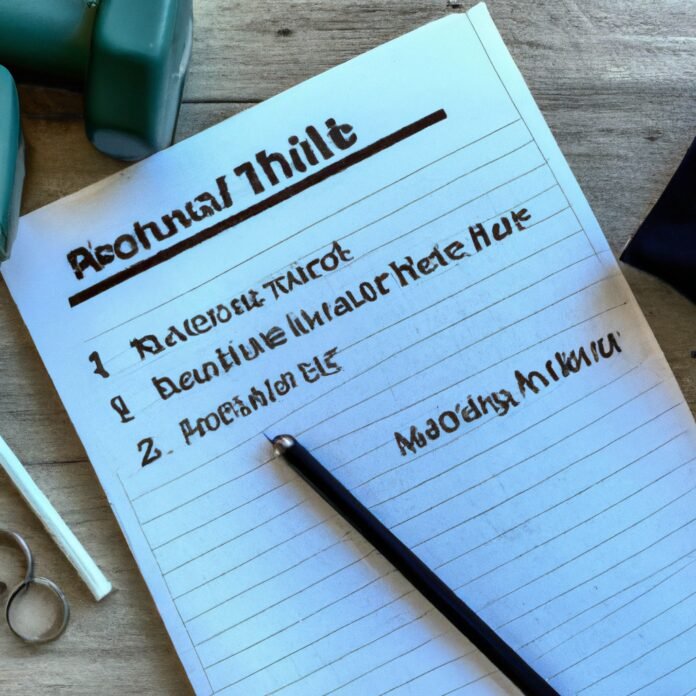Are you looking to improve your physical health and wellbeing, or seeking to kickstart a healthier lifestyle? Creating a fitness routine and building a workout plan that works best for you can be an intimidating thought, but it doesn’t have to be. In this article, we’ll discuss the steps you need to take in order to design your own workout plan and get on the path to reaching your fitness goals.
1. Taking the First Step: Establishing Goals for Your Routine
Are you looking to start a new workout routine? Taking the first step doesn’t have to be overwhelming. All that’s needed is setting achievable goals. Once that’s done, achieving the desired outcome is sure to follow.
Start by taking a good look at your current lifestyle. After all, there’s no point devising an exercise plan that’s going to be impossible to keep up with. Ask yourself key questions such as:
- When am I available to work out?
- How many days per week am I able to dedicate to exercise?
- Can I fit in more than one workout in one day?
Armed with this information, you can start to put together goals that are realistic and achievable. Consider how to increase daily physical activity by planning a workout for each day of the week. This could include exercise classes like yoga and pilates, resistance training or outdoor activities such as running or biking. Once the days and times have been scheduled in a diary, itEUR(TM)ll be easier to stick to your plan.
For instance, some may find it easier to exercise in the morning whereas others are night owls and may prefer to workout later in the day. Noting this down and sticking to it when designing your routine is another way to increase motivation. Short term achievable goals can help you along the way and keep you on track.
As you work on increasing physical activity, you can replace unhealthy habits with healthy ones. Give yourself specific targets such as repeat exercise twice a week and don’t miss any sessions over a two-week period. If you do, make sure to get back on track straight away and continue to review and adjust your plan regularly.
2. Crafting Your Perfect Workout Plan for Optimal Results
Whether you are an elite athlete or a novice health enthusiast, it pays to craft a workout plan that will deliver maximum results. Here are our top tips for constructing a plan that meets your goals.
- Define What You Want to Achieve. Get specific. Do you want to build strength? Tone muscle? Increase stamina? Improve mobility? It’s important to identify and prioritize what type of outcome you seek so that you set yourself up to succeed.
- Consider Your Time Commitment. Chart out the amount of time available to you for exercise and plan accordingly. If life gets in the way, be prepared to adjust as needed.
- Choose the Right Exercises. To get the most out of your workout time, pick movements that target multiple muscles or that require you to move your body through space. Mixing cardio, strength training, and stretching helps to ensure that you are working all of your body’s muscles and systems.
- Focus on Intensity. Make sure your plan incorporates periods of higher intensity so that you really get the most out of your time. High-intensity exercises help you to burn more calories and to stimulate muscle growth more than low level activity.
You know your body best – listen to it! As important as it is to have a plan, do not be afraid to stray from it if something isn’t working. The perfect plan is an individualized one and must constantly evolve with you.
When it comes to results, there is no one-size-fits-all approach. Rest assured, with a little planning and experimentation, you can craft the perfect workout plan for yourself.
3. Planning Your Workouts for Maximum Efficiency
When planning your workouts, it’s important to take into account the time commitment, the intensity and frequency of your workouts, and the available equipment. This is a critical element in creating an efficient and effective workout routine.
The following points will help you strategize and schedule your workouts for maximum efficiency:
- Set a schedule. Planning your workouts in advance will give you a better understanding of the time commitment needed, and help you prioritize exercise on your to-do list.
- Choose the right exercises. Not all exercises are created equal, so consider your goals and select exercises that target the correct muscles and work for your available equipment.
- Optimize your rest time. Rest time between sets can differ depending on the goal, and between exercises. The goal is to balance recovery time with the intensity of the workout.
- Track your progress. This will help you stay motivated by charting your progress over time.
Finally, remember to tailor your workouts to your overall health and fitness needs. At the end of the day, being able to reach your fitness goals is the key to success and planning your workouts ahead of time is an effective way to do this.
4. Overcoming Workout Obstacles to Reach Your Goals
Taking on the challenge of achieving fitness goals can be hard if you lack direction or don’t know how to take on the necessary steps. These obstacles can prevent you from reaching your goals, but there are ways to get past these struggles.
- Set Reasonable Goals
First, set goals that are adaptive to your lifestyle, and don’t overly tax yourself. If your goals prove too difficult to reach at this time, they will only make it harder to stay motivated and remain confident. It’s important to create attainable goals, no matter how small they may be, to help you keep advancing.
- Find A Support System That Works For You
Having someone to motivate you through tough times can be essential in fighting the obstacles that stand in your way. Whether it’s a fitness buddy, a fitness-oriented mentor, or a workout group, it is beneficial to get a support system in place to help you stay on track.
- Start Slow And Increase Intensity Slowly
It’s important to not limit yourself or quickly jump into something that’s too difficult for your fitness experience. Challenge yourself incrementally, and gradually build up the intensity of your workouts to help you find success. This will help challenge you, while ensuring that you don’t become overwhelmed or discouraged.
- Track Your Progress
Tracking and mapping out where you are on a regular basis can help demonstrate to yourself the hard work you’re putting in. Whether it’s tracking the amount of weight you’re lifting in the gym or measuring the distance you’ve ran for the day, logging and visualizing progress can help to give you the reward that will keep you going.
Creating a routine and building a plan that sets up the foundation for your long-term fitness goals is an exciting journey. No matter what your long-term goals may be, a well-crafted plan can help you take the necessary steps towards achieving them. With the right mindset and approach, coupled with a commitment to yourself, you can become the best version of you!



